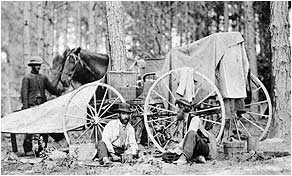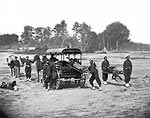Mathew Brady - Mathew B. Brady Biography (1823-1896)
Whether you know his name or not,
you've seen Mathew Brady photographs. Mathew Brady is one of the best-known
photographers, both in his time and in ours. He was a highly successful portrait
photographer who essentially invented documentary photography and
photojournalism, and he contributed significantly to our understanding of the
U.S. Civil War. Nevertheless, he ultimately sacrificed his wealth, his
livelihood and his health for his art and died impoverished and
underappreciated.
Mathew Brady learned the new art of
photography as a teen from inventor Samuel Morse. He quickly perfected the
daguerreotype process and opened a portrait studio to much acclaim on Broadway
in New York City in 1844. He convinced many of the most powerful and famous
people of the day to sit for his portraits, including presidents, political
leaders, businessmen, writers, military generals and more. He was a master at
marketing his craft, luring buyers into his studio by lining it with portraits
of the social and political elite and calling it a "Hall of Fame." Far more than
just a business venture, Brady felt photography was his calling and it was his
duty to historically document the people who were shaping America. He became one
of the first people to document history with the camera. After winning the
presidential election, Abraham Lincoln even credited the distribution of Brady’s
carte de visite portraits of him for winning the election.
|
 |
 |
 |
|
Cornelius Vanderbilt from a
daguerreotype by Mathew Brady |
Mathew
Brady's Portrait Gallery
Broadway and Tenth Street in New York City |
Civil War
General George A. Custer from a wet collodian glass negative by Mathew
Brady |
In 1861, at the height of his
career as a portrait photographer with several large studios and a considerable
fortune, Mathew Brady turned his focus to the Civil War. He later said, "I had to go. A
spirit in my feet said 'Go,' and I went." He hired 18 photographers, supplied
each of them with a full wagon photographic studio, and set out to document the
realities of war. Photographers such as Alexander Gardner, and Timothy O’
Sullivan took on the job. Along with Brady, these men are now regarded as early
masters of photography. While his photographers documented most of the
war, they were under contract to attach Brady’s name to every image taken. Brady
sank all of his energy, his fortunes and ultimately his health into the cause of
documenting the Civil War in photographs. He’s said to have spent over $100,000
on the effort, at a time when the average American made $300 a year.
 |
|
One of the Mathew Brady photo crews outside of Petersburg, VA.
|
In 1862 Mathew Brady presented his
photographs from the Battle of Antietam to the public in New York City,
entitling the exhibition "The Dead of Antietam." For the first time, average
citizens saw the carnage of war. Since the photos required long exposures, the
photos captured the moments before and after most of the action. The public saw
the vibrancy of life in the faces of those prior to battle, juxtaposed with the
gruesome images of contorted corpses on the battlefield. The New York Times
commented, “If he [Brady] has not brought bodies and laid
them in our door-yards and along our streets, he has done something very like
it.” While traditional journalists were sending tales filled with
half-truths romanticizing the war, Brady’s photographs spoke an undeniable and
never before witnessed truth about how destructive and grotesque war is.
Civil War Photos by Mathew
Brady and His Team of Photographers.
|
 |
 |
 |
|
Union observation balloon. |
Soldiers of 4th New York heavy
Artillery loading 24-pdr. siege gun. |
Battlefield at Antietam on the
day of battle. This is the only known photo during a battle of the Civil
War. |
 |
 |
 |
|
Ambulance drill in the field. |
1st African American infantry
unit. |
Civil War Confederate
casualties at Antietam. |
After the war Mathew Brady found that
people preferred to forget the war, and his expectation that his war photographs
would be treasured and reap him financial reward proved elusive during his
lifetime. Within a few years, he was forced to file bankruptcy. He eventually
sold his glass negatives of the war to the United States government and received
a grant from Congress for the rights to his photographs. His total take of just
over $25,000 wasn’t enough to cover his debts. By the time of his death in 1896,
his contributions to photography and the documentation of U.S. history were
recognized, but certainly underappreciated. His glass negatives in the hands of
the government had been allowed to severely degrade, and a majority of the
collection had been split up and sold off. He died poor and in relative
obscurity.
Today we more fully
recognize Brady's contributions to photography, journalism and history. The
majority of his images have been acquired by the Smithsonian Institution and the
U.S. Library of Congress in Washington D.C.
Buy a Mathew Brady Collection Photo
We offer a broad selection of
Mathew Brady photos on our website that we have
painstakingly restored to remove significant dust, scratches, and in many cases,
cracks in the original glass plate negative. We're also happy to print the
original un-restored image on request. If you’re interested in another photo by
Mathew Brady, just
contact us.
We have hundreds of images currently in the editing and restoration process and
have access to much more of the Brady Collection.
Robert's Recommended Websites on
Mathew Brady:
“Mathew Brady’s Portraits,” from The
Smithsonian Institution’s National Portrait Gallery
This is a very impressive site from
the Smithsonian’s National Portrait Gallery. You can go through Brady’s virtual
gallery, read about the subjects of each of his photographs, and learn how Brady
and his contemporaries made photographs (long before Kodak, this required a
wagon full of chemicals and equipment).
Mathew Brady Bio on Dickenson
College Website
A pretty good essay, presumably by a
student at Dickenson College
“Brady’s Portrait of Grant,” by Jeff
Galipeaux
Great piece on Brady inventing
candid portraiture in June, 1864, when he captured a candid (or more
specifically awkwardly posed) shot of General U.S. Grant in the field.
And if you need more online
material, there's always Google:
Robert's Recommended Books on Mathew Brady (these open a new window to
Amazon.com):
If you found this article interesting, you may also want to join Robert's
monthly newsletter. Each month he features a particular historically significant
photographer, introducing you to that person's work and how the person has contributed to the world of photography. You'll also get free access to our screensavers, exclusive discounts,
and updates on our newest additions to the RMP Archive. Enter your email address
in the form below.